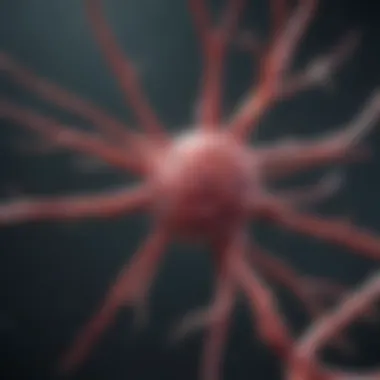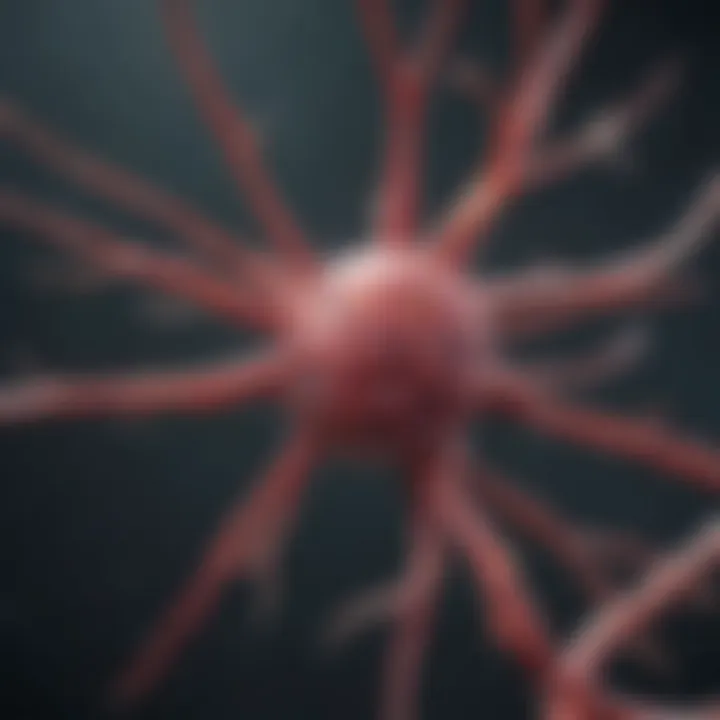Genetic Influences on Brain Aneurysms Explained


Intro
Brain aneurysms are bulges that develop in the walls of blood vessels in the brain. They can lead to serious complications, including hemorrhage, which can result in severe neurological damage or even death. Increasing evidence suggests that genetics plays a significant role in the predisposition to brain aneurysms. This article aims to delve into the genetic influences, shedding light on how hereditary factors contribute to this complex condition.
The exploration of genetic contributions to brain aneurysms encompasses various dimensions, including the examination of specific genes and the molecular mechanisms at play. By outlining the key findings from recent research, this article seeks to clarify the implications for diagnostics and treatment, enhancing our understanding of this critical area in neurology.
Key Findings
Summary of the main results
Research has identified several genes that exhibit associations with brain aneurysm susceptibility. Studies have pointed to genetic variants present in both the ELN and MMP genes, among others, as contributors to vascular abnormalities. A familial predisposition to aneurysms has also been observed, suggesting that individuals with a family history are at a heightened risk. Furthermore, advances in genetic testing have enabled better screening options for at-risk populations, illustrating how genetics informs strategies for diagnosing brain aneurysms.
"Understanding the genetic basis of brain aneurysms can facilitate early intervention and more tailored management strategies across affected populations."
Significance of findings within the scientific community
The significance of these findings is multi-faceted. A deeper understanding of the genetic factors not only enhances the general knowledge in neurology but also encourages medical professionals to consider genetic testing as part of routine assessments in high-risk groups. The identification of genetic markers can lead to improved patient outcomes as it allows for earlier detection and possibly preventive measures for those identified as at risk. The research landscape continues to evolve, emphasizing the necessity for clinicians and researchers to integrate genetic data into their practice and studies.
Implications of the Research
Applications of findings in real-world scenarios
The findings from ongoing genetic research have immediate applications in clinical settings. For instance, individuals who have a family history of brain aneurysms could benefit from earlier imaging studies, such as MRI or CT scans, to monitor for the formation of aneurysms. Genetic counseling is becoming increasingly pivotal, providing families with the support and knowledge necessary to understand their risks.
Potential impact on future research directions
Future research may focus on unraveling the complex interactions between genetic and environmental factors contributing to brain aneurysm formation. It is anticipated that ongoing studies will refine genetic testing techniques, making them more accessible and accurate. Moreover, the development of targeted therapies that address specific genetic pathways presents a promising horizon in the treatment of brain aneurysms, reinforcing the importance of genetics in medical research and practice.
Prolusion to Brain Aneurysms
Brain aneurysms, sometimes referred to as cerebral aneurysms, represent a localized dilation of a segment of an intracranial artery. This medical condition is significant as it can lead to severe neurological consequences, including hemorrhagic strokes. Understanding brain aneurysms involves looking at both their anatomical structure and the factors that may contribute to their formation and rupture.
Within this article, we will explore various aspects of brain aneurysms, starting from their definition and anatomy to genetics and risk factors. A thorough understanding of these elements is crucial not only for medical professionals but also for patients and families affected by this condition. By unpacking the breadth of research surrounding aneurysms, particularly the genetic influences, we can offer insights that are beneficial for risk assessment, diagnosis, and potential therapeutic strategies.
Interestingly, brain aneurysms do not always present clear symptoms until they reach a critical point, making them a silent threat in many cases. Moreover, their hereditary nature adds complexity to both screening and management. Genetic predispositions can play a substantial role in determining who might be at risk. This knowledge can pave the way for more personalized approaches to treatment and prevention.
As we delve deeper into this topic, we will emphasize the importance of understanding genetic markers, familial aggregation, and molecular mechanisms involved in aneurysm development. Our aim is to provide a robust framework for recognizing how genetics contributes to brain aneurysms. This is more than just an academic exploration; it has real-world implications for individuals at risk. By fabricating a connection between genetics and clinical practices, we hope to enhance awareness and improve outcomes for those affected by this condition.
Defining Brain Aneurysms
Defining brain aneurysms is essential for understanding their impact on health. An aneurysm in the brain is a localized dilation or bulging of a blood vessel. It occurs due to a weakness in the wall of the blood vessel. This definition emphasizes the structural integrity of the vasculature, which is crucial in the context of blood flow and overall brain health.
Being able to identify and characterize brain aneurysms can significantly benefit both diagnosis and treatment. Early identification may lead to timely interventions and potentially better outcomes for patients. Additionally, understanding their specific characteristics, such as size and location, helps clinicians assess the risk of rupture and develop appropriate management strategies.
Anatomy of a Brain Aneurysm
The anatomy of a brain aneurysm includes several key components. It usually consists of three main parts: the dome, the neck, and the base. The dome is the protruding part, the neck connects the dome to the blood vessel wall, and the base is where the aneurysm attaches to the artery.
Anatomically, the most common location for the formation of aneurysms is the circle of Willis, a ring-like structure at the base of the brain. This area is rich in arterial branches, making it a common site for hemodynamic stress and subsequent aneurysm development.
The size of brain aneurysms can vary considerably. Some may be as small as a few millimeters, while others can grow larger than a centimeter or more. Larger aneurysms pose a greater risk of rupture, which is a serious concern as it can lead to hemorrhagic stroke and other severe complications.
Symptoms and Diagnosis


Symptoms of brain aneurysms can vary widely. Many aneurysms are asymptomatic and may go undetected until they rupture. However, in some cases, individuals may experience specific signs. Common symptoms include headaches, vision changes, and neurological deficits. These indicators can prompt further investigation.
Diagnosis often involves imaging techniques such as CT scans, MRI, or angiography. CT angiography is particularly useful for visualizing the structure of blood vessels and aiding in the assessment of aneurysm presence and characteristics. Additionally, consistent follow-up for patients with known aneurysms is crucial to monitor any changes that may occur over time.
"Understanding the definition and anatomy of brain aneurysms is the first step in risk assessment and management."
Genetics and Aneurysm Formation
Understanding the relationship between genetics and the formation of brain aneurysms is essential in the field of neurology and vascular health. Aneurysms, which are abnormal bulges in blood vessels, pose significant health risks, including the potential for rupture and subsequent hemorrhage. Genetic factors can play a critical role in these abnormalities, informing both risk assessment and treatment strategies.
By investigating the genetic influences, researchers can identify individuals who may be predisposed to developing brain aneurysms. This knowledge opens pathways for improved monitoring and intervention methods, potentially saving lives. Furthermore, understanding genetic contributions aids scientists and clinicians in developing targeted therapies, optimizing patient outcomes, and fostering personalized medicine approaches in managing aneurysm-related health issues.
The Role of Heredity
Heredity significantly contributes to the risk of brain aneurysms. Family history appears to be a major factor, indicating that genetic predisposition is a driving force behind susceptibility.
Research shows that individuals with relatives diagnosed with aneurysms have a higher likelihood of developing similar conditions. The familial link suggests that specific genes or mutations may increase the propensity for vascular abnormalities.
Key findings include the following:
- Some studies show an increased risk of aneurysms in first-degree relatives of affected individuals.
- Genetic studies indicate possible inheritance patterns, emphasizing the need for awareness among families with a history of aneurysms.
Identified Genetic Markers
Recent genetic research has identified several specific markers associated with brain aneurysms. These markers contribute to our understanding of how DNA variations may impact the integrity of blood vessel walls and regulate normal vascular functions.
Among these markers, certain single nucleotide polymorphisms (SNPs) have been implicated. Elevated attention is directed toward the following genes:
- ELN (Elastin): Linked with the structural integrity of blood vessels.
- MMP (Matrix Metalloproteinases): Involved in the remodeling of the extracellular matrix, playing a role in aneurysm formation.
By identifying these genetic markers, researchers can better predict which individuals are at higher risk, leading to proactive measures to mitigate potential aneurysms.
Familial Aggregation of Aneurysms
Familial aggregation refers to the increased incidence of brain aneurysms within certain families. Numerous studies confirm that individuals with a family history of brain aneurysms are more likely to experience this condition themselves.
A meta-analysis revealed key insights:
- Families with one affected member often show multiple other cases, indicating shared genetic risk factors.
- The aggregation not only reflects heredity but may also encompass environmental and lifestyle components that coincide within familial contexts.
Understanding familial aggregation assists in developing screening strategies for at-risk relatives. As a result, early interventions may be pursued, which could significantly alter the prognosis for individuals who are genetically predisposed to aneurysms.
Molecular Mechanisms Behind Aneurysm Development
Understanding the molecular mechanisms that lead to aneurysm development is crucial in comprehending how genetic factors contribute to this condition. The interplay between genetic predispositions and various biological processes shapes the vulnerability of blood vessels. Insights into these mechanisms can guide researchers and clinicians in identifying potential therapeutic targets and improving patient outcomes.
Vascular Remodeling Processes
Vascular remodeling refers to the adaptive changes in blood vessel structure in response to a variety of stimuli, including genetic and environmental factors. In the context of brain aneurysms, this process involves abnormalities in the extracellular matrix (ECM), smooth muscle cells, and inflammatory responses.
Mechanistically, vascular remodeling can lead to the weakening of arterial walls, a critical factor in aneurysm formation. Key elements include:
- Extracellular Matrix Alterations: Changes in ECM composition can impact the integrity and stability of blood vessels, increasing the likelihood of aneurysm development.
- Smooth Muscle Cell Dysfunction: Abnormalities in the contractile properties of smooth muscle cells can impair vascular tone, contributing to the dilation of the vessel wall.
- Inflammatory Responses: The presence of inflammation within the vascular wall may further compromise structural integrity, leading to aneurysm progression.


In essence, these vascular remodeling processes are crucial to understand because they not only elucidate why some individuals may develop aneurysms but also open avenues for targeted therapy and prevention strategies.
Genetic Pathways Implicated
The genetics behind aneurysm development are influenced by multiple pathways that highlight the complex interaction between genes and vascular biology. Several pathways that are frequently implicated include:
- Angiogenesis Pathways: Genes involved in new blood vessel formation, such as VEGF, can influence vascular resilience.
- Matrix Metalloproteinases (MMPs): These enzymes play a significant role in ECM remodeling. Overactivity of MMPs can lead to excessive degradation of the ECM, a key player in aneurysm formation.
- Cell Cycle Regulation Genes: Disruption in the regulation of the cell cycle can affect smooth muscle cell proliferation, impacting vascular stability.
Understanding these genetic pathways provides insights into why certain individuals are at a higher risk for aneurysm formation. By identifying specific genes and their functions, targeted interventions may be developed.
These aspects of the genetic landscape are vital for informing both research initiatives and clinical approaches towards brain aneurysms, underlining the need for comprehensive studies in this field.
Risk Factors Beyond Genetics
In understanding brain aneurysms, it is crucial to explore factors beyond genetic influences. While genetics play a significant role, the environment and individual lifestyle choices contribute heavily to the risk of developing these vascular abnormalities. Identifying these elements helps in creating a more comprehensive view of patient risk and guides targeted interventions.
Environmental Influences
Environmental factors can considerably impact the likelihood of aneurysm formation. Certain geographical and socio-economic considerations show correlations with increased prevalence of these conditions. For instance, those living in regions with high levels of air pollution tend to demonstrate a higher incidence of vascular disorders, including brain aneurysms.
Key environmental aspects include:
- Exposure to toxins: Chronic exposure to chemicals such as heavy metals can weaken blood vessels, increasing aneurysm risk.
- Hypertension: Environmental stressors, often linked to socioeconomic status, can contribute to chronic high blood pressure, a known risk factor for aneurysms.
- Temperature fluctuations: Extreme weather conditions may also play a role in vascular health and can exacerbate pre-existing conditions.
Healthcare providers could consider these factors when assessing a patient’s risk. Often, it is necessary to look at a person’s living environment as part of a thorough risk assessment.
Lifestyle Factors
Lifestyle choices are another critical area impacting the risk of brain aneurysms. Healthy behaviors can mitigate risk, while unhealthy habits can amplify it. Adopting a proactive approach to wellness can significantly influence vascular health.
Some lifestyle factors to consider include:
- Smoking: Nicotine and other harmful substances in tobacco cause damage to blood vessels, increasing the risk of aneurysm formation.
- Diet: A diet high in saturated fats and low in fruits and vegetables can contribute to vascular issues. A balanced diet can aid in maintaining overall vascular integrity.
- Physical Inactivity: Sedentary lifestyles can lead to obesity and hypertension, both proven factors in aneurysm risk. Regular exercise promotes healthy blood flow and reduces stress on the vascular system.
Moreover, stress management is essential. Chronic stress can lead to hypertension and thereby escalates the risk of brain aneurysms. Building resilience and finding effective stress-relief tactics may be important in a comprehensive health strategy.
"Understanding that factors beyond genetics also play a significant role allows for more effective prevention and treatment mechanisms in managing brain aneurisms."
In summary, while genetics is a critical component in the study of brain aneurysms, understanding the influence of environmental and lifestyle factors is equally valuable. Addressing these non-genetic aspects can help reduce the risk and improve overall outcomes for those at risk of brain aneurysms.
Genetic Testing in Aneurysm Risk Assessment
Genetic testing plays a vital role in assessing the risk of developing brain aneurysms. By understanding the genetic components involved, individuals can gain insights into their susceptibility to this condition. This section delves into the advancements in genetic testing and the ethical considerations that surround this practice.
Advancements in Genetic Testing
Recent advancements in genetic testing have significantly improved our ability to identify individuals at risk for brain aneurysms. Technologies such as next-generation sequencing allow for the simultaneous analysis of multiple genes associated with aneurysm formation. This comprehensive approach helps pinpoint specific genetic markers that correlate with increased risk.
Furthermore, large-scale genomic studies have led to the discovery of several loci linked to intracranial aneurysms. For example, variants in genes like HMGA2 and PICALM are noted in various studies as having strong associations with aneurysm development. The integration of bioinformatics tools has also enhanced the interpretation of genetic data, providing clearer guidance for clinical decision-making.
The main benefits of these advancements include:
- Early Detection: Individuals from families with a history of brain aneurysms can undergo testing for genetic predispositions, enabling early monitoring and preventive measures.
- Tailored Approaches: Results can guide personalized medicine, adjusting treatment plans based on specific genetic risk factors.
- Research Opportunities: These advancements foster research on the molecular pathways involved in aneurysm formation, leading to potential new therapies.


Ethical Considerations of Genetic Testing
When considering genetic testing in aneurysm risk assessment, ethical considerations must be taken into account. The knowledge of one’s genetic risks can have profound implications not only for the individual but also for family members.
Key ethical aspects include:
- Informed Consent: Patients must fully understand what the testing entails, including potential outcomes, benefits, and risks.
- Privacy Concerns: Genetic information is sensitive. Safeguarding this data from unauthorized access is crucial to maintain patient privacy.
- Psychological Impact: The results of genetic tests can lead to anxiety or altered perceptions of health. Individuals may struggle with the implications of potential aneurysm development.
- Discrimination Risks: There are concerns regarding possible discrimination by insurers or employers based on genetic predispositions.
As genetic testing continues to evolve, it will be critical to balance innovation with ethical practices to protect individuals and their families.
Implications for Clinical Practice
Personalized Medicine Approaches
Personalized medicine represents a growing trend in healthcare, emphasizing tailored treatments that suit the unique genetic profile of each patient. In the context of brain aneurysms, this might involve various strategies:
- Targeted Interventions: By identifying specific genetic markers linked to aneurysm risk, clinicians can potentially implement early interventions for patients with a familial history.
- Drug Customization: Certain medications may be more effective based on a patient's genetic information. This customization can improve treatment outcomes and reduce adverse side effects.
- Tailored Follow-Up Protocols: Genetic insights can guide decisions on monitoring frequency and methods, ensuring that high-risk patients receive timely intervention.
The integration of genetic information into clinical practice not only elevates the standard of care but also provides patients with clearer expectations regarding their health.
Screening Recommendations for High-Risk Groups
Establishing effective screening protocols for those at higher risk is another crucial aspect influenced by understanding genetic factors. Identifying high-risk groups enables medical professionals to prioritize resources effectively. Some considerations include:
- Family History Assessments: Performing routine family history evaluations to identify individuals with a higher genetic predisposition to brain aneurysms is vital. This can lead to earlier and more frequent imaging tests for those at risk.
- Standardized Genetic Testing: Institutions may develop screening recommendations that incorporate genetic testing for relatives of diagnosed individuals, thereby identifying those who may not yet show symptoms but are genetically predisposed.
- Awareness Campaigns: Educating healthcare providers about the importance of assessing genetic risks could lead to enhanced screening for patients who meet specific criteria, such as those with multiple family members affected by aneurysms.
In summary, the genetic research surrounding brain aneurysms establishes a foundation for improved clinical practices. Personalized medicine and targeted screening recommendations tailored to high-risk individuals underscore the importance of integrating genetic insights into patient care. This proactive approach can effectively minimize the risks associated with brain aneurysms, ultimately improving patient outcomes.
Current Research Directions
Current research on the genetic influences of brain aneurysms is critical for understanding and improving patient outcomes. By focusing on both emerging studies and future therapeutic prospects, this section will contribute significantly to the broader discussion on aneurysm management. The study of genetics in relation to brain aneurysms provides insights into risk assessment and potential treatment methodologies. Understanding genetic predispositions can lead to more informed clinical decisions and better screening practices for at-risk populations.
Emerging Studies on Genetic Factors
Recent studies have increasingly highlighted the interplay between genetic factors and brain aneurysm formation. Researchers are identifying numerous genes associated with aneurysm susceptibility, such as the ELN, COL3A1, and MMP2 genes. These genes relate to structural components of blood vessel walls, influencing both strength and stability.
Moreover, genome-wide association studies (GWAS) have pinpointed specific risk loci that contribute to aneurysm development. For example, studies have demonstrated that variations in the C11orf70 gene are linked to an increased risk of developing intracranial aneurysms. Researchers are diving deeper into the genetic landscape, aiming to elucidate how these genetic variations manifest in physical conditions conducive to aneurysm formation.
Emerging studies also emphasize personalized medicine by combining genetic information with traditional risk factors, such as family history and lifestyle choices. Such an integrative approach could enhance early detection methods, leading to better patient management and preventative strategies.
Future Prospects for Gene Therapy
The potential for gene therapy in treating brain aneurysms remains a topic of great interest. With the advancements in genetic editing technologies like CRISPR-Cas9, researchers are exploring the possibility of correcting genetic mutations at a specific site within an individual's genome. This could provide a revolutionary new avenue for treatment, particularly for individuals with identified genetic risk factors.
Studies in animal models show promising results, suggesting that gene therapy might not only prevent the formation of aneurysms but could also lead to regression of existing aneurysms. The focus is primarily on targeting the mechanisms of vascular remodeling and inflammation that contribute to aneurysm growth.
The effective application of gene therapy requires significant research to determine delivery mechanisms, optimal timing, and potential side effects. Current trials are assessing the safety and efficacy of such treatments in human subjects.
"The intersection of genetics and brain aneurysm research offers a pathway to innovative treatment options that may alter the course of this disease."
End
The significance of concluding this article lies in consolidating the insights gained about the genetic influences on brain aneurysms. Throughout this exploration, we have detailed the intricate interplay of genetic factors, hereditary patterns, and the molecular processes involved in aneurysm formation. Understanding these elements is crucial for multiple reasons.
Firstly, recognizing the hereditary nature of brain aneurysms enables healthcare professionals to better evaluate patients' family histories. This awareness can lead to earlier diagnosis and intervention strategies, ultimately improving patient outcomes. As the article illustrates, certain genes have been identified as potential markers for increased risk. Having access to this knowledge helps clinicians to tailor screening and surveillance protocols based on individual patient profiles.
Additionally, insights into genetic testing advancements underscore its role in shaping personalized medicine approaches. The ability to predict aneurysm risk through genetic analysis can significantly influence preventative measures and treatment plans. Patients might benefit from proactive management strategies that are aligned with their unique genetic makeup.
Moreover, the ongoing research in this domain presents a hopeful outlook for the future of aneurysm management. By continuing to uncover genetic influences, the field is positioned to discover novel therapeutic targets. Such progress can ultimately lead to the development of gene therapies, providing innovative solutions that were previously not feasible.
In summary, this article reinforces the importance of considering genetic factors in understanding brain aneurysms. The implications extend beyond diagnosis; they touch upon prevention, personalized treatment, and future research directions. As the field evolves, remaining attuned to these influences may significantly enhance clinical practice and patient care.







